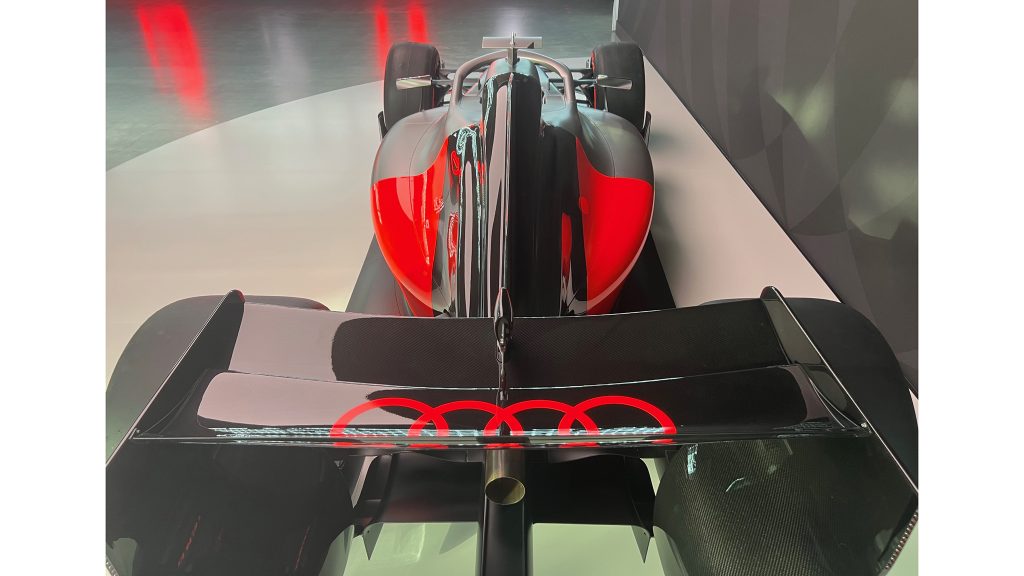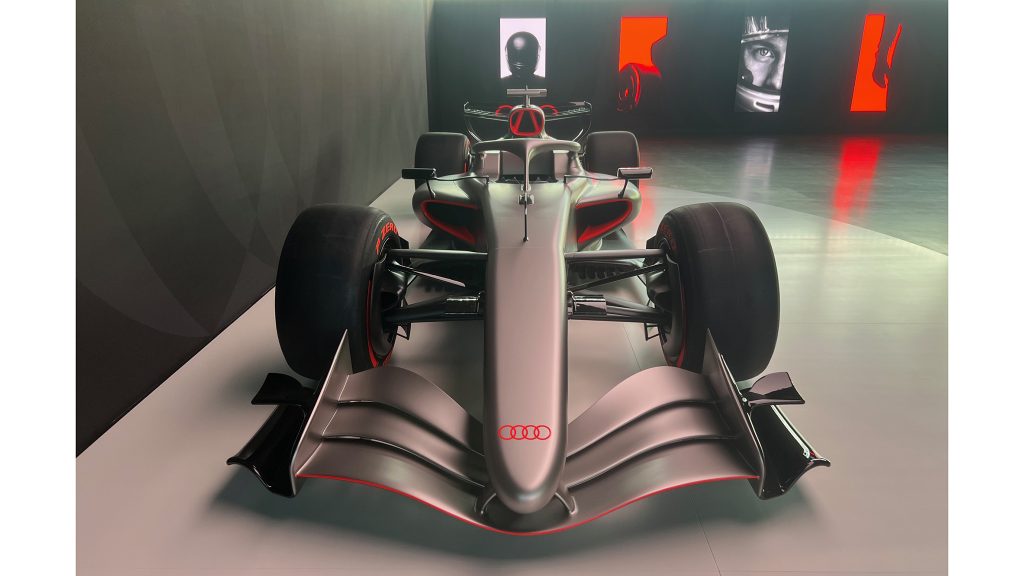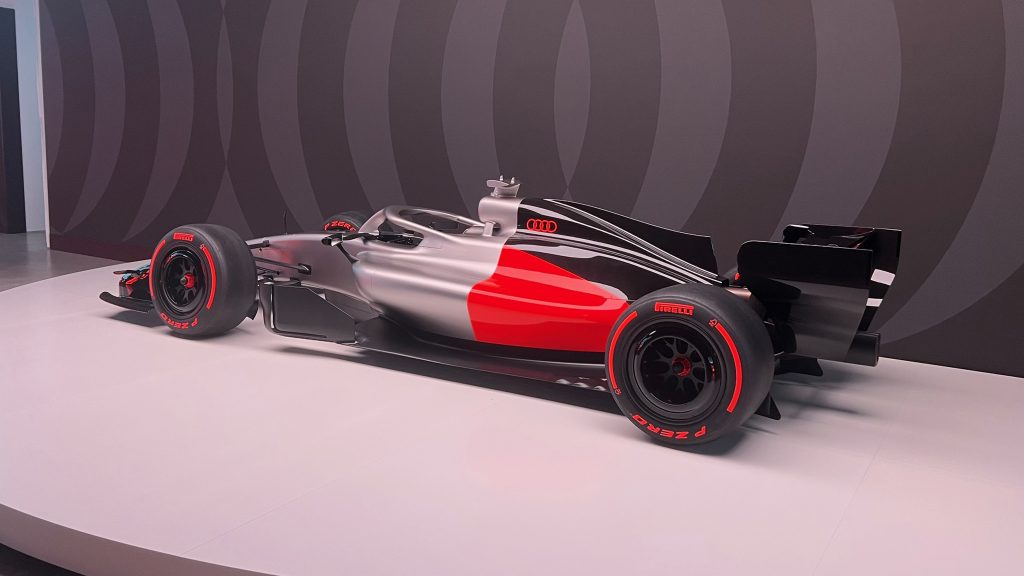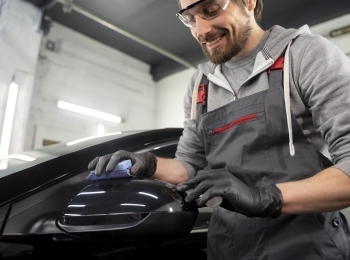Audi has officially stepped into the world of Formula 1, and fans are finally getting their first real look at what the German automaker’s debut car will look like. The new Audi R26 Concept, revealed at a special event in Munich, Germany, previews the livery that will race under the Audi name when the company takes full control of the Sauber F1 Team in 2026.
This will be Audi’s first-ever F1 entry, and Nico Hülkenberg and Gabriel Bortoleto will drive the cars. The event marks a major milestone for the Volkswagen Group-owned brand as it prepares to join motorsport’s biggest stage.
A Fresh Look That Screams “Audi”
The R26 Concept may not be a fully functional car yet, but it provides fans with a clear idea of Audi’s Formula 1 identity. The livery blends Germany’s classic silver racing color with Audi’s signature Lava Red and black carbon fiber accents.
The front half of the car is painted in a sleek titanium silver, while the rear section glows with Lava Red, a new tone Audi says represents the next generation of its design language. The black areas, meanwhile, are actually exposed glossy carbon fiber, though the real race car might feature a matte finish to reduce weight, a common trick in Formula 1.
Even the tires on the show car got a special touch, with a custom Lava Red sidewall design replacing Pirelli’s usual soft-tire red marking. The look is clean, modern, and unmistakably Audi, instantly recognizable when it hits the grid in March 2026. See more photos






Simple, Sharp, and Sponsor-Ready
While some might call the design a bit conservative compared to other F1 teams, there’s no denying it’s refined and distinctly Audi. The four-ring logo appears prominently on the nose, engine cover, and rear wing.
Audi’s design team also hinted that this livery is very close to what the actual 2026 car will wear, with only minor tweaks expected once sponsor logos are finalized. The automaker already has major partners lined up, including Revolut (title sponsor), Adidas (official apparel provider), and BP and Castrol (fuel and lubricant partners). More sponsorship announcements are expected in the coming months.
Audi Takes Over Sauber, A Historic Move
Rather than starting from scratch like Cadillac’s new F1 effort, Audi is taking full control of the established Sauber F1 team. Sauber has a long history in Formula 1, dating back to 1993, and has previously partnered with Mercedes, BMW, and Alfa Romeo.
Interestingly, this means Sauber will have now worked with all three of Germany’s automotive giants: Mercedes-Benz, BMW, and now Audi. Over the years, Sauber has achieved strong results, including a second-place finish in the 2007 Constructors’ Championship during its BMW era, and a historic win at the 2008 Canadian Grand Prix with Robert Kubica.
Now, with Audi’s full factory support and resources, the team hopes to return to the podium and, eventually, the top step.
Big Plans, Big Investments
Audi is not entering F1 halfway. The company has been building up its racing infrastructure for several years in preparation for 2026. It now operates across three major sites:
- Hinwil, Switzerland – Sauber’s long-time headquarters, home to one of F1’s most advanced full-scale wind tunnels.
- Neuburg, Germany – Audi’s motorsport facility, where the new 1.6-liter turbo-hybrid power unit is being developed and built.
- Silverstone, UK – A new base near the heart of Britain’s F1 industry, serving as a support center.
Altogether, Audi’s F1 program now employs around 750 team members, with roughly 430 focused on the powertrain alone. The company has hired more than 250 new employees over the past two years to strengthen its technical and engineering teams.
Chasing 2030 Glory
Audi’s entry into Formula 1 comes at a perfect time. The 2026 F1 regulations will bring an all-new era with smaller, lighter cars and a major shift toward 50% electric hybrid power, up from 20% today. This levels the playing field, giving newcomers like Audi a fair shot to compete with established teams.
Still, there’s no hiding the challenge ahead. Developing a top-tier hybrid power unit from scratch is one of the toughest engineering feats in motorsport. Audi acknowledges this and has set 2030 as its target year to be fighting for race wins and championships.
Mattia Binotto, the former Ferrari boss who now leads Audi’s F1 project, summed it up best during the Munich reveal:
“It’s possible, but ambitious. It could take longer.”
Audi knows success in Formula 1 takes time, data, and relentless development, but the brand is confident its mix of German engineering and Sauber’s experience can deliver results.
What’s Next for Audi in F1
For now, fans can only admire the R26 Concept as a bold promise of what’s to come. The real car will make its first official appearance on track in early 2026 at the Australian Grand Prix in Melbourne, marking the start of a new era not just for Audi, but for Formula 1 itself.
Audi’s entry signals a growing trend of major automakers returning to F1 as the sport shifts toward sustainable hybrid technology. With its eye-catching design, solid foundation, and long-term vision, Audi’s journey from concept to competition could become one of the most exciting stories in modern F1 history.
In short: Audi’s first-ever Formula 1 car blends sleek design, historic ambition, and cutting-edge hybrid tech. It’s not just a new look, it’s a bold statement that Audi is ready to compete with the best in the world.
FAQs
When will Audi join Formula 1?
Audi will officially enter Formula 1 in 2026. The team will make its debut at the first race of the 2026 season, which is expected to happen in March 2026 in Melbourne, Australia.
Which F1 team is Audi taking over?
Audi is taking full control of the Sauber F1 team, a Swiss-based racing team that has been in Formula 1 since 1993. Audi will rebrand the team under its own name starting in the 2026 season.
Who will drive for Audi in Formula 1?
The first two drivers for Audi’s F1 team will be Nico Hülkenberg and Gabriel Bortoleto. Hülkenberg is an experienced F1 driver, while Bortoleto is a young talent making his move up to the top level of racing.
What does Audi’s new F1 car look like?
Audi’s F1 car features a silver front, Lava Red rear, and black carbon fiber details. The design is clean and modern, with Audi’s four-ring logo displayed on the nose, sides, and rear wing. It looks simple, but is very recognizable on the track.
What engine will Audi use in Formula 1?
Audi is building its own 1.6-liter turbo-hybrid engine for Formula 1. The new F1 rules require the cars to get half their power from electricity and half from the engine, so Audi’s unit will mix gas and electric power for better efficiency and performance.
Why is Audi entering Formula 1 now?
Audi chose to join F1 now because the new rules start in 2026. These rules focus more on hybrid power and efficiency, giving new teams a fair chance to compete. It’s also a good way for Audi to test new technology for its future cars.
How long will it take Audi to win races in Formula 1?
Audi plans to fight for wins and championships by around 2030. The team knows success in F1 takes time because it needs to build data, test its engines, and improve the car’s performance year by year.
What makes the 2026 F1 rules different?
The 2026 F1 cars will be lighter, smaller, and more energy-efficient. They’ll use 50% electric power from hybrid systems and have less downforce for closer racing. This makes it a fresh start for all teams, including new ones like Audi.
Why does Audi’s F1 car not have sponsors on it yet?
The car shown in Munich was a show model, not the final race version. Audi hasn’t revealed all of its sponsors yet, but it confirmed partnerships with Revolut, Adidas, and BP/Castrol. The real race car will include sponsor logos when it debuts in 2026.












Leave a Reply